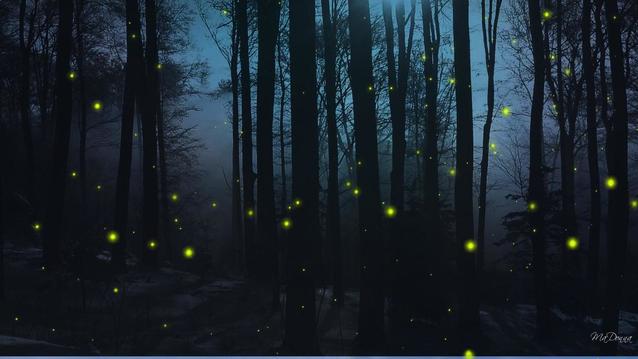Fate Of The Disappearing Fireflies
By James Donahue
As a child growing up in rural Michigan, I was always delighted each summer when the fireflies came out at dusk. Sometimes the yard would be filled with their tiny twinkling lights as they danced and flitted around us.
One of the last marvelous memories of Michigan, before my wife and I sold our home near Cass City and began our adventures in Arizona, was that of sitting in our yard with friends and being surrounded by fireflies. Their silent little flashing added a magic to each evening. The field across the road was so filled with these little creatures it sometimes appeared to be ablaze with flickering lights.
We rarely see fireflies now.
Scientists lament that these marvelous little creatures are disappearing all over the world. They blame pollution, urban sprawl, and the general encroachment of humans for their disappearance. They theorize the spread of artificial lighting also may be the problem since it disrupts the intricate mating behavior that depends on the male winning over a female with its flashing.
Indeed, this is what was going on each night as we watched them fly around us. They were in a mating ritual. It was nature’s call for love and mating, not only for the fireflies, but for all of us.
While people of our generation remember the fireflies filling the air, people today say it is rare when they see a single flash in the night sky. It may happen so fast they don’t realize what it was they were looking at.
The firefly, also known as “lightning bugs” and “glowworms” aren’t flies, bugs or worms at all. They are, in biological terms, winged beetles that contain rare and unique chemicals called luciferin and luciferase that produce cold light, or bioluminescence. The study of these insects has actually led to the new flashlights and flares now on the market.
It is a sad thing to think these little creatures will soon be lost to us. They don’t bite, they never carry disease, they are not poisonous, but they give great pleasure when they are around. Also medical researchers have discovered that the chemicals used by the beetles to make cold light also can be used in research on cancer, multiple sclerosis, cystic fibrosis and heart disease.
The fact that science and now industry has found a market for the rare chemicals used by the firefly to produce light may also be part of the cause of their fast disappearance. Some companies are paying well for large numbers of captured fireflies. That is because the chemicals, luciferin and luciferase cannot be produced synthetically.
Unfortunately, because of their very nature, fireflies do not fly very fast, they live and fly close to the ground, and in the evening when they are glowing, they are easy to capture.
By James Donahue
As a child growing up in rural Michigan, I was always delighted each summer when the fireflies came out at dusk. Sometimes the yard would be filled with their tiny twinkling lights as they danced and flitted around us.
One of the last marvelous memories of Michigan, before my wife and I sold our home near Cass City and began our adventures in Arizona, was that of sitting in our yard with friends and being surrounded by fireflies. Their silent little flashing added a magic to each evening. The field across the road was so filled with these little creatures it sometimes appeared to be ablaze with flickering lights.
We rarely see fireflies now.
Scientists lament that these marvelous little creatures are disappearing all over the world. They blame pollution, urban sprawl, and the general encroachment of humans for their disappearance. They theorize the spread of artificial lighting also may be the problem since it disrupts the intricate mating behavior that depends on the male winning over a female with its flashing.
Indeed, this is what was going on each night as we watched them fly around us. They were in a mating ritual. It was nature’s call for love and mating, not only for the fireflies, but for all of us.
While people of our generation remember the fireflies filling the air, people today say it is rare when they see a single flash in the night sky. It may happen so fast they don’t realize what it was they were looking at.
The firefly, also known as “lightning bugs” and “glowworms” aren’t flies, bugs or worms at all. They are, in biological terms, winged beetles that contain rare and unique chemicals called luciferin and luciferase that produce cold light, or bioluminescence. The study of these insects has actually led to the new flashlights and flares now on the market.
It is a sad thing to think these little creatures will soon be lost to us. They don’t bite, they never carry disease, they are not poisonous, but they give great pleasure when they are around. Also medical researchers have discovered that the chemicals used by the beetles to make cold light also can be used in research on cancer, multiple sclerosis, cystic fibrosis and heart disease.
The fact that science and now industry has found a market for the rare chemicals used by the firefly to produce light may also be part of the cause of their fast disappearance. Some companies are paying well for large numbers of captured fireflies. That is because the chemicals, luciferin and luciferase cannot be produced synthetically.
Unfortunately, because of their very nature, fireflies do not fly very fast, they live and fly close to the ground, and in the evening when they are glowing, they are easy to capture.
